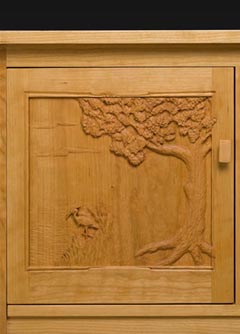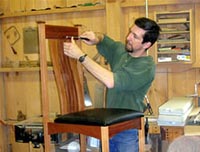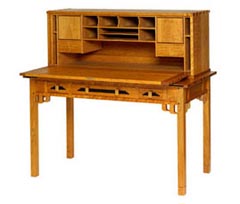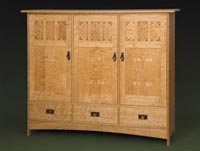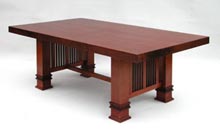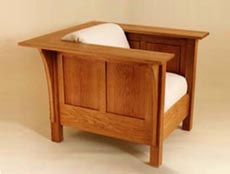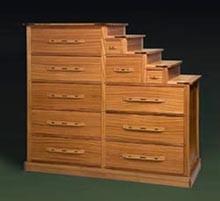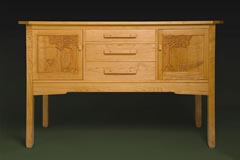
If you look at the bulk of William LaBerge’s work, you’d probably call it Greene and Greene, though by his own admission he uses that merely as a jumping-off point for his own designs. “Rather than doing reproductions, which I’ve done in the past,” LaBerge explains, “I am starting to make my own versions of Greene and Greene and other styles, and it’s very exciting.”
He’s quick to point out that, like him, the Greene brothers also blended and interpreted existing styles. “Greene and Greene had a huge Asian influence. I call it Santa Fe meets Japan. There’s fluidity, movement and attention to detail that make them different, on close inspection, than they first appear from afar. For instance, on my version of the Blacker House Sideboard, the carvings flow onto the rails and stiles of the doors and the bead breaks and angles in at the top and bottom.
“On pieces like my Prairie Chair, which I do with either panels or spindles in the sides, I like to make the arm from one piece of wood so that the grain runs continuously all the way around the piece. The panels are also all taken from one board, as are the rails and stiles. A lot of people don’t notice that, but the continuous grain is far less jarring and more pleasing to the eye, in my opinion. Once you point that out to a customer, they start looking for it on other pieces. It’s one way I educate my customers to the difference between what I do and some of the other work out there.”
Though he boasts a deservedly excellent reputation as a detail-oriented fine woodworker now, he actually started out in a very different field of endeavor, and picked up woodworking as more or less a second career. “I went to the University of Vermont and graduated in 1982 with a degree in communications,” he recounted, “then moved to New York City and got into the film industry. I worked as a gaffer, which is the chief lighting technician, and as best boy, which is the gaffer’s assistant. I’ve worked with Jodie Foster, Robin Williams, Jackie Gleason and even worked on PeeWee’s Playhouse with Paul Reubens.
“When we decided we wanted to have kids, my wife and I moved back to Vermont. It was 1988, and I needed to find work. I met a furniture maker in Vermont whose work, exact Shaker reproductions, appealed to me, and I asked him for a job. As luck would have it, he had just gotten together with a business consultant who told him to find someone with a baby and a mortgage, traditionally the most reliable sort of employee, and hire him or her. I walked in with my pregnant wife and got hired. It was perfect timing.
“Though I had never done any woodworking prior to that, I apprenticed with him for about three and a half years. He was good at teaching me how to teach myself, meaning he would throw articles at me about whatever I needed to do for the next project. He expected me to read them and learn how to do it. I’m sort of self-taught under his tutelage.
“Although he was not a very good businessman, he was good at translating the lines and styles of furniture and was very meticulous about design elements. He understood them. As a result, I learned not only how to read style, but also how not to run a business. His business was faltering; I left to start my own business, and his closed a year after. To tide me over, I did some construction work while making pieces to place in galleries.
“My original training was doing Shaker and Mission style pieces, including Stickley reproductions, but what appealed most to me was Greene and Greene. I started showing my Greene and Greene pieces around 1992, but called them Arts and Crafts because people back then were not that familiar with the now well-known brothers. I remember a couple showing up at my door one day while I was photographing a bunch of my pieces. I told them, ‘These are my Arts and Crafts pieces.’ to which they replied, ‘You mean Greene and Greene.’ They had just bought The Blacker House and were about to do a restoration on it.
“After eating a lot of boxed macaroni and cheese for a while, I got work on the redesign of the Equinox Hotel, which had just been bought by the Guinness Corporation. At the time, I was doing a lot of Mission style furniture, and they commissioned me to do about 16 large pieces for one of their presidential suites. Last fall, after another resale and redesign of the hotel, many of the pieces I made got auctioned off. I saw a few. For having been in a hotel for 16 years, the pieces were in remarkably good shape.
“Soon after that, I built a new shop and took over some of the accounts from my now out of business former employer. At that point, I grew to about six employees. Eventually it dawned on me that I was mostly writing paychecks, designing cut lists and fixing employees’ errors. In 1998, I decided to get out of the wholesale business and do only custom work. I moved to another city in Vermont with a better school system for my kids, built a new shop and shed all my employees. These days, I work with one helper.”
I asked Bill to talk about some of the pieces he personally likes best, and he pointed out several. “A couple who collect player pianos, and of course rolls for them, commissioned a pair of cabinets to hold the rolls,” he told me. “It’s one of my favorite pieces. The case is cherry with quilted maple panels and walnut and quilted maple inlay. I wish I had owned it a bit longer so I could have photographed it after the cherry had darkened a bit more. Another favorite is the Frank Lloyd Wright table, which is in quartersawn oak and boasts a walnut nosing around the top that blends seamlessly from oak to walnut.
“I’ve always wanted to do something with more traditional Japanese lines and construction, and one day a customer asked for just that. She needed a dresser that had to step down to fit under a sloped ceiling. I made her the Kaidan-Dansu Chest, which means ‘step chest’ in Japanese, and at the same time, made one for myself as well. The fact that I got the commission for the piece was what allowed me to make one for myself.
“The Mission Table, which I offer both as a round table and as an oval extension table, is one of my more popular pieces. I could probably make a living doing the same table over and over, but I always want to do the next one, take the next step and learn something else. That means using new woods, finishes, styles and techniques. Recently, I’ve started adding inlay, in both wood and silver, and plan to experiment with other materials as well. I also like to collaborate with others. I’ve done pieces with a carver, a painter, a person who makes handblown glass and an upholsterer.
“I’m also heavily involved in an environmental alliance in the area, and am trying to incorporate more environmental living both into my life and my work. I try to use environmentally friendly products, like sustainably harvested wood, and natural coatings from Vermont Natural Coatings
“What keeps me going in this is that I can continually learn new techniques and keep evolving. I belong to the Vermont Furniture Makers organization. At our quarterly meetings, each host is required to show something new: a new technique, idea, jig or whatever. We push each other, create a springboard for new ideas and get critiques from one another. For me, it is perhaps the best aspect of being in that group.”
